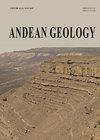阿根廷巴塔哥尼亚圣克鲁斯省西北部中新世早期Cerro Boledoras组的脊椎动物化石
IF 1.2
4区 地球科学
Q3 GEOLOGY
引用次数: 1
摘要
早-中中新世大陆Cerro Boleadoras组(CBF)生长在阿根廷圣克鲁斯省西北部Meseta del Lago Buenos Aires西坡的Cerro Boleadoras和Cerro Plomo地区。CBF的下部由横向广泛的中卵石砂岩层组成,具有槽状交错层理,可解释为河道沉积,与板状细粒洪泛平原沉积互层。最近的野外调查提供了这些水平的脊椎动物化石,估计年龄在~16.5 Ma至15.1 Ma之间(burdigian晚期- Langhian早期)。研究剖面与南巴塔哥尼亚的Austral-Magallanes盆地的Santa Cruz组(SCF)中上剖面、智利的Río Frias组和北巴塔哥尼亚的Collón-Curá组下剖面在时间上重叠。我们编制了该地区的综合动物名单,包括以前收集的标本,并讨论了其年代和古环境意义。该分类群列表包括了在SCF中记录的大多数类群:一种无脊椎动物,三种鸟类,以及至少33种哺乳动物(异肢动物,异肢动物,穴居动物,无节肢动物和洞穴形啮齿动物),表明了一个圣克鲁斯时代的感觉。我们还记录了一只龟,它构成了南美洲和世界上最南端的龟的记录。CBF与上述Santa Cruz、Río Frías和Collón-Curá地层的脊椎动物化石含量的区系差异可能反映了生态、气候和地理差异,而不是时间差异。树栖或半树栖、食食、果食和食草哺乳动物的共存表明,在CBF岩石占据的地区,树木和开放环境都存在。然而,无法辨别这两种环境是共存还是交替存在,以及一种环境是否优于另一种环境。标记类群,如栗鼠(chinchillid啮齿动物)Prolagostomus和Pliolagostomus,以及typothere Pachyrukhos,表明中新世在巴塔哥尼亚南部有干旱化的趋势,如先前报道的沿Río Santa Cruz和Río Coyle以南的SCF上部,沿大西洋海岸和Río Gallegos。本文章由计算机程序翻译,如有差异,请以英文原文为准。
Fossil vertebrates of the early-middle Miocene Cerro Boleadoras Formation, northwestern Santa Cruz Province, Patagonia, Argentina
The early–middle Miocene continental Cerro Boleadoras Formation (CBF) crops out in the area of Cerro Boleadoras and Cerro Plomo on the western slope of the Meseta del Lago Buenos Aires, northwestern Santa Cruz Province, Argentina. The lower levels of the CBF consist of laterally extensive medium to pebbly sandstone beds with trough cross-bedding, interpreted as fluvial channel deposits, interbedded with tabular fine-grained floodplain deposits. Recent fieldwork provided fossil vertebrates from these levels with an estimated age between ~16.5 Ma and 15.1 Ma (late Burdigalian-early Langhian). The studied section temporally overlaps with the middle or upper sections of the Santa Cruz Formation (SCF) in the Austral–Magallanes Basin of southern Patagonia, the Río Frias Formations in Chile, and the lower Collón-Curá Formation of northern Patagonia. We compile an integrated faunal list for this locality, including specimens from previous collections, and discuss its chronological and paleoenvironmental implications. The taxa list includes most of the groups recorded in the SCF: one anuran, three birds, and at least 33 mammals (metatherians, xenarthrans, litopterns, notoungulate typotheres and caviomorph rodents), indicating a Santacrucian age sensu lato. We also recorded a testudine, which constitutes the southernmost record of tortoises in South America and worldwide. Faunal differences between the vertebrate fossil content of the CBF and the mentioned sections of the Santa Cruz, Río Frías and Collón-Curá formations may reflect ecologic, climatic and geographic differences rather than temporal ones. The co-occurrence of arboreal or semiarboreal, browsing, frugivorous, and grazing mammals suggests the presence of both trees and open environments for the area occupied by the CBF rocks. However, it is not possible to discern whether these two environments coexisted or alternated, and whether one environment predominated over the other. Marker taxa, such as the chinchillid rodents Prolagostomus and Pliolagostomus, and the typothere Pachyrukhos indicate a trend to aridification during the Miocene in southern Patagonia, as previously reported for the upper part of the SCF along the Río Santa Cruz and south to the Río Coyle, along the Atlantic coast and the Río Gallegos.
求助全文
通过发布文献求助,成功后即可免费获取论文全文。
去求助
来源期刊

Andean Geology
地学-地质学
CiteScore
3.90
自引率
0.00%
发文量
17
审稿时长
>12 weeks
期刊介绍:
This journal publishes original and review articles on geology and related sciences, in Spanish or English, in three issues a year (January, May and September). Articles or notes on major topics of broad interest in Earth Sciences dealing with the geology of South and Central America and Antarctica, and particularly of the Andes, are welcomed.
The journal is interested in publishing thematic sets of papers and accepts articles dealing with systematic Paleontology only if their main focus is the chronostratigraphical, paleoecological and/or paleogeographical importance of the taxa described therein.
 求助内容:
求助内容: 应助结果提醒方式:
应助结果提醒方式:


